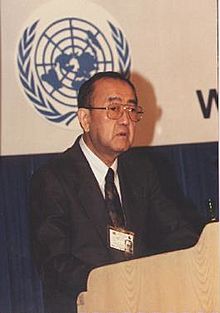Hiroshi Nakajima facts for kids
Quick facts for kids
Hiroshi Nakajima
|
|
|---|---|
|
中嶋 宏
|
|

Nakajima in 1995
|
|
| 4th Director-General of the World Health Organization | |
| In office 1988–1998 |
|
| Secretary General | Javier Pérez de Cuéllar (1982–1991) Boutros Boutros-Ghali (1992–1996) Kofi Annan (1997–1998) |
| Preceded by | Halfdan T. Mahler |
| Succeeded by | Gro Harlem Brundtland |
| Personal details | |
| Born | May 16, 1928 Chiba, Empire of Japan |
| Died | January 26, 2013 (aged 84) Poitiers, France |
| Alma mater | Tokyo Medical University (MD) International University of Health and Welfare (PhD) |
| Signature |  |
Hiroshi Nakajima (中嶋 宏, Nakajima Hiroshi, May 16, 1928 – January 26, 2013) was a Japanese doctor. He is most famous for being the leader of the World Health Organization (WHO) for ten years.
Contents
Early Life and Education
Hiroshi Nakajima was born in Chiba, Japan, on May 16, 1928.
In 1955, he earned his medical degree (M.D.) from Tokyo Medical University in Japan. After that, he continued his studies in Paris, France. Later, after 1967, he also received a PhD in medical sciences in Japan.
Professional Career
Working in France and Japan
From 1956 or 1958 until 1967, Nakajima worked at the French National Institute of Health and Medical Research. There, he focused on medical and pharmaceutical research. After his time in France, he went back to Japan. He became the research director for Nippon Roche, which was a Japanese part of the company Hoffmann-La Roche.
Joining the World Health Organization
Nakajima started working at the World Health Organization (WHO) in 1974. His first role was as a Scientist, focusing on how drugs were evaluated and monitored. In 1976, he became the Chief of the WHO Drug Policies and Management Unit.
In this role, he helped create the idea of essential drugs. These are medicines that are considered most important for a basic healthcare system. He was the Secretary for the first group of experts who discussed this topic.
Around 1978 or 1979, the WHO Regional Committee for the Western Pacific chose Nakajima as their Regional Director. He held this important position for two terms. In 1988, he was elected to lead the entire WHO as its Director-General.
First Term as WHO Director-General (1988–1993)
In January 1988, the WHO executive board voted for Nakajima to become the Director-General. He won the vote 17 to 14 against Carlyle Guerra de Macedo from Brazil.
During his time as leader, Nakajima faced some challenges. He had different ideas from Jonathan Mann, who was in charge of the WHO's Global Programme on AIDS (GPA). Mann believed Nakajima was not doing enough to fight AIDS. This disagreement led to Mann leaving his position. The Global Programme on AIDS saw a big drop in staff after this.
Despite these challenges, an important program was launched during his first term. In 1988, the Global Polio Eradication Initiative began. This program aimed to get rid of polio worldwide.
Second Term as WHO Director-General (1993–1998)
In May 1993, Nakajima was re-elected for a second term as Director-General. The vote was 93 to 58. Some major countries that gave money to WHO, like the United States, did not support his re-election. There was some discussion around this re-election. An audit was done in March, which found that Nakajima had not misused WHO's money.
Nakajima ran against Mohammed Abdelmoumene, who was an Algerian doctor and had been Nakajima's deputy. Nakajima had removed him from his position earlier.
In 1997, Nakajima announced that he would not seek another re-election. His term ended in July 1998. Gro Harlem Brundtland from Norway took over as the new Director-General.
Death
Hiroshi Nakajima passed away on January 26, 2013, in Poitiers, France. He had been ill for a short time.
See also
 In Spanish: Hiroshi Nakajima para niños
In Spanish: Hiroshi Nakajima para niños

